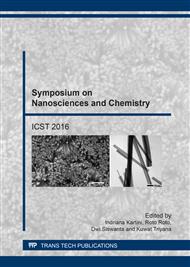p.142
p.149
p.154
p.160
p.166
p.173
p.182
p.190
p.197
Coconut Shell Charcoal as a Bioreductor in Roasting Process of Nickel Laterite from Pomalaa, Southeast Sulawesi: Performance and Kinetics Study
Abstract:
In facing the scarcity of sulfide nickel ore, processing nickel laterite to form nickel pig iron becomes an important issue. Also, Indonesia inherits 10% of nickel laterite in the world, assigning as the third biggest country of nickel laterite possession in the world. Nickel pig iron is one of nickel products involving massive high-grade metallurgical coke consumption that is commonly being used as stainless steels. Consequently, high amount of carbon dioxide is also produced in this process. And so, substituting of the coke using bioreductor material – in this study, Coconut Shell Charcoal – is important. The study is done by conducting several variables. The reductors used were Coconut Shell Charcoal and Anthracite Coal. The process was conducted in 800°C and 1000°C, in a muffle furnace, and between 15 to 240 minutes of reduction time. Results from all reductors show that higher temperature indicates a better reduction process. Moreover, X-Ray Powder Diffraction (XRD) analysis data shows that there is no significant difference in the final product between two reductors. By replacing metallurgical coke using bioreductor, the carbon emission in the process can be reduced. Hence, providing a better process and environment to the next generation.
Info:
Periodical:
Pages:
182-189
Citation:
Online since:
July 2017
Keywords:
Price:
Сopyright:
© 2017 Trans Tech Publications Ltd. All Rights Reserved
Share:
Citation:


